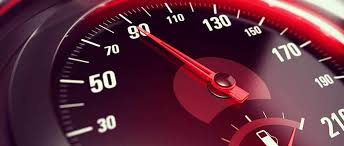People are always on the go these days. Most of us have hectic schedules. Schedules that require us to get from point A to point B without a minute to spare. We’re running late for work or an appointment. There’s a child waiting to be picked up at school. Even the most law-abiding upstanding citizen has driven faster than the posted speed limit at some point. But is making anything on time really worth a high-speed car crash? A serious automobile accident that can injure or kill you or others. It’s a reckless and negligent act that’s all too common and just part of our everyday hustling.
Yes, exceeding the speed limit – or driving too fast for conditions – increases your risk of being in an auto accident. So, if you came here looking to confirm that there’s nothing really bad or unsafe about driving too fast, sorry. Here are a few reasons speeding contributes to collisions and other types of car accidents.
SPEEDING INCREASES YOUR RISK OF LOSING CONTROL OF YOUR VEHICLE
Someone driving beyond the speed limit or too fast for road conditions is more likely to lose control of their vehicle. When this happens, they’re more likely to swerve into oncoming traffic, up onto a sidewalk with pedestrians, or collide with a tree, utility pole, or another type of barrier or object. Most vehicle rollovers can also be attributed to driving too fast and flipping over the vehicle.
SPEED AFFECTS IMPACT & STOPPING DISTANCE
The faster someone is driving, the more distance they’ll need to stop. If a vehicle’s speed doubles, it’ll need 4x the distance to come to a stop. Similarly, the faster you drive, the greater impact there is when your car crashes into another vehicle or object. You’re also shortening the time you have to react to roadway debris or a stopped vehicle. This means you won’t have enough space to brake and avoid a collision. You also won’t have enough time to turn or react to traffic lights, a highway exit sign, or navigation system directions, which can also result in losing control of the vehicle, swerving, a rollover, or high-speed collision.
HIGH-SPEED COLLISIONS USUALLY RESULT IN MORE SEVERE INJURIES OR FATALITIES
Severe whiplash is very common in high-speed collisions. This can bring you a lifetime of neck and back pain. It can also worsen any pre-existing neck and spinal injuries you may have. In a serious high-speed car accident, temporary or permanent paralysis is possible given the rate of impact. Head injuries are also very common. Although you’re wearing a seat belt, and most vehicles should have airbags deploying on impact, you can still bang your head off the steering wheel, the dashboard, the windshield, or the interior roof or sides of the car. In a high-speed car crash, this impact can end your life or cause a traumatic brain injury (TBI). Internal bleeding or injuries are also much more common in high-speed car accidents. Again, this is all due to the force of impact.
VEHICLE SAFETY FEATURES MIGHT NOT WORK AS WELL AT HIGHER SPEEDS
Safety features like seatbelts and airbags protect drivers and passengers from sustaining more severe injuries. This is because they reduce the force of impact. But there have been numerous instances where these features fail in some cars when speeding is a factor. Something like an airbag taking a second or two too long to deploy in an accident is enough to seriously hurt or kill someone.
INJURIED IN A HIGH-SPEED CAR ACCIDENT IN LOS ANGELES?
If you or a loved one were hurt in an accident where speeding was a factor, the attorneys at M.R. PARKER LAW, PC are available for a free consultation. Let’s talk and figure out how much your case is worth. Call us today at (818) 334-5711 or fill out our online form to get the compensation you deserve for your pain and suffering.



